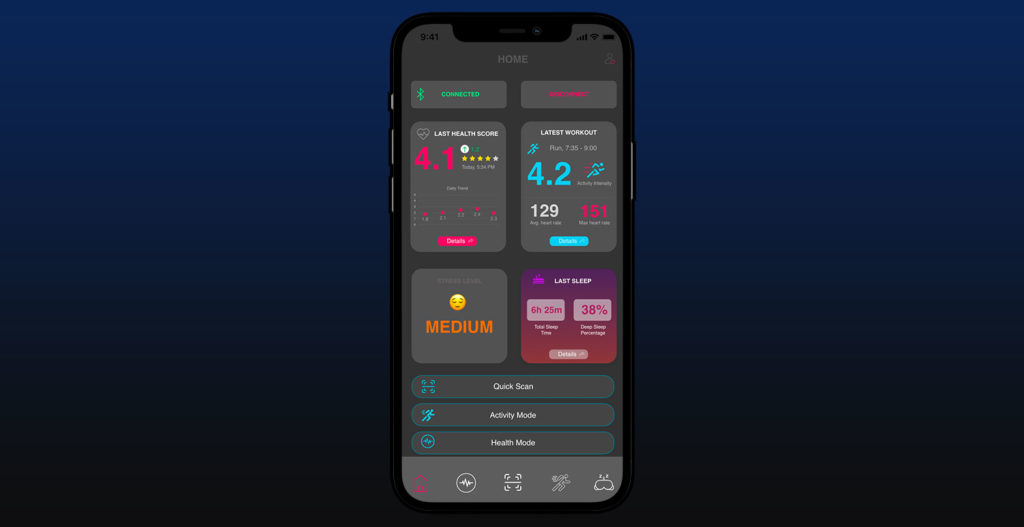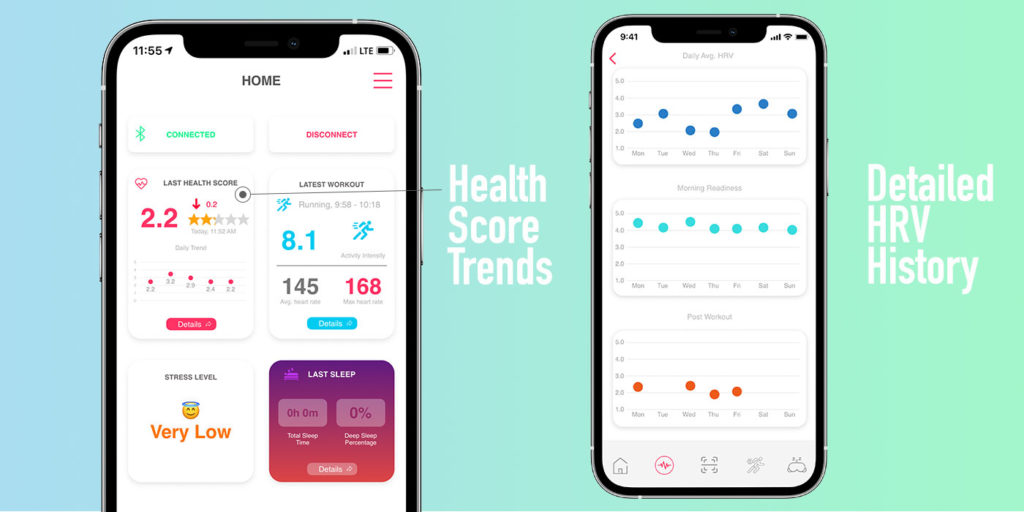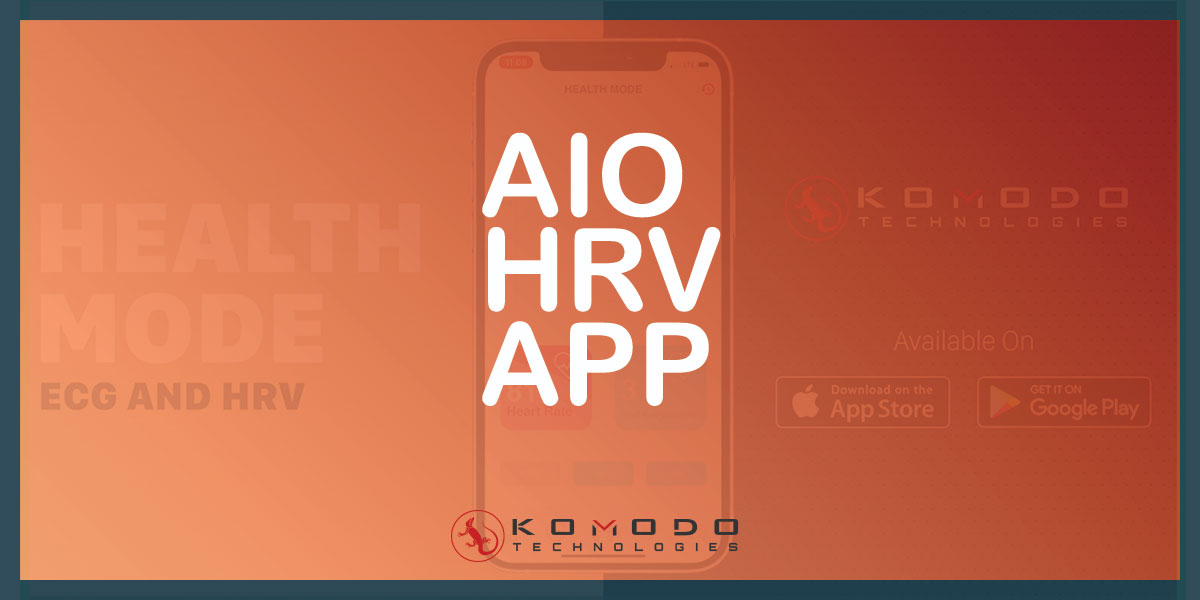In this Article
- ECG-Based HRV
- Events Based Tracking
- Stress Level
- Komodo vs Apple Watch vs Fitbit vs Whoop
- Other Good HRV apps
It’s 2023, and the number of HRV enthusiasts is growing rapidly. It has taken some time, but people are finally ditching the step trackers and moving on to tracking something much more important. Heart rate variability is like our body’s check engine light. It provides insight into the complex mind-body-brain connection, the autonomic nervous system and overall health. With daily HRV use, you can unlock information about your internal health like never before. It’s truly mind-blowing! Today we’ll be taking a close look at the best HRV app on the market. Not to mention some other HRV apps that are doing a great job.
For the most part, wearable technology is split in to two categories: 1) Activity trackers and 2) medical wearables. The prior doesn’t have enough information and the latter is very specialized and extremely expensive. Heart rate variability is right in that sweet spot. It’s for those who want more than just step tracking, but less than Afib detection. The medical wearables typically tailor to the elderly and those with pre existing conditions. Heart rate variability wearables are great for anyone looking to optimize their daily routine, find things that work and don’t work and prepare for the later years. Being healthy is a full-time, long-term commitment. There is no such thing as “biohacking”. you have to be patient and put the time in, only then will HRV have great benefits.
When it comes to HRV technology, it’s very important to understand how things work. Sales jargon from companies (including ours) is great, but when you know how the science and the sensors work, you will actually figure out the best ways to optimize. Companies use different sensors and different formulas to acquire HRV data and each product has a different way of presenting said data.
ECG-BASED HEART RATE VARIABILITY
Let’s start from the beginning. All wearable devices have two ways of extracting an HRV value: 1) optical sensor and 2) an electrocardiogram (ECG / EKG). An optical sensor shines a light through your skin to measure tissue changes of blood circulation and calculated BPM. This is used by most fitness trackers like Fitbit and Garmin. An electrocardiogram uses leads placed on the body to measure electrical activity of the heart. This is used by the more sophisticated devices on the market.
So which one is better?
To answer that question we need to consider ‘sample rate’. This is how often the device communicated with the app when collecting data. Optical sensor typically have a max sample rate of 50 per second. That means every second, 50 data points are captured.
ECG has a sample rate anywhere between 200-500 samples per seconds. A significant difference. The AIO Smart Sleeve has a sample rate of 350 per second.
Another thing to note, not all devices that have ECG / EKG capability use it to capture heart rate variability. Apple, as an example, has ECG capability but they use the optical sensor to capture that data. The AIO Health app is the only HRV app that provides you with an ECG-based HRV score.
The difference? Significantly more accurate, less false positives and a clearer picture. In fact, the AIO Smart Sleeve is the only consumer device that uses ECG-based HRV monitoring. Fitbit falsely claimed they did the same, but we debunked that theory. We received drawback from the video in this article, but we made sure to explore our claim and confirm the facts.
EVENTS-BASED TRACKING
What’s even more important than accuracy is how to group this data and help you actually make life-changing health decisions. Simply recording HRV every couple of hours with no goal or organization is pointless.
That’s why Komodo Technologies created ‘events’. Based on what you’re doing during the day, you can select an event prior to recording HRV. Each event has its own section in the history section (which we will show later).
These events include morning readiness, before and after work, post meal, post workout and several others. The main question we used to get a lot was “how do I know what affected my HRV, was is physical or mental”?
HRV can be quite ambiguous at times, but the AIO Health App removes many of these questions. It allows you to measure HRV for these different events and view the trends based on the event selected. So, if your average HRV on a certain day is low, you can view each event and see where things went south.
Some of these events include:
Morning Readiness
Perhaps the most common event. Morning readiness will usually be your highest HRV value of the day. It’s goes downhill from there. But this way you can see the starting point and how far from that baseline you reach throughout the day, and why certain days are better or worse.
Alcohol
Alcohol is a very interesting one. You would think it lowers HRV for everyone, but it really depends on the individual. Some people use booze as a de-stressor. So, there is a point to which HRV might not decrease after intake. Once you start really hitting the sauce, then it will go down.
This is up to each individual to figure out for themselves (with the help of an HRV app). Every individual will also have different internal response based on which alcohol they are consuming (beer, whiskey, wine, etc.) You might have a favorable heart rate variability from certain types of alcohol. Ones that don’t put too much pressure on your organs.
Food Sensitivity
Very similar to alcohol, eating food triggers digestion in your body. This puts stress on your body and will lower HRV. Everyone digests food at different rates. Someone who eats poorly (lots of junk food, highly processed) is putting extreme pressure on the body to digest as opposed to someone who eats clean.
Think of a car that a backup of sludge under it, on the frame and around the engine. It won’t be running smoothly and can cause other damage down the line. But again, each person responds to every food differently. You need to try foods, measure HRV and make proper decisions based on what your body is telling you.
STRESS LEVEL
Heart rate variability is a well-known predictor of stress. The AIO Health App uses the previously discussed ‘events’ from the HRV test to generate a stress level. The events deemed as mental stressors (vs physical stressors) are what are used to generate an average stress level score. You can see this on the home screen of the app.

TRENDS
HRV trends can be found in the history section of the AIO Health App. Each event is grouped individually, which gives you a clearer breakdown of how your HRV measures up throughout the day.

You can see the trajectory of your HRV daily, and based on each event.
KOMODO VS APPLE WATCH VS FITBIT VS WHOOP (best hrv app?)
If your looking for an HRV tracker, you’ve come across these products and apps. Each has their own spin on heart rate variability.
Apple is simple, but confusing to the end user. The app is monitoring your HRV all day using the bpm sensor on the watch. When you check the result on the app watch,, you see a value in milliseconds, i.e. 30 ms, 50 ms, etc. They use a time domain method called SDNN.
There are two ways to measure HRV; 1) time domain and 2) frequency domain. All consumer grade wearables and apps will use one of two time domain analyses. Time domain HRV monitoring is split in to two main categories (though there are several others). These are SDNN (as discussed) and RMSSD.
SDNN (method of HRV extraction on Apple Watch) takes the daily average HRV and then shows the average deviation from that average (mean) throughout the day. Not very effective.
Whoop uses the RMSSD method, with the optical sensor. This will measure the time difference in heart beats for each successive beat. So it’s pretty much a live stream of your HRV as opposed to the Apple Watch.
The AIO Sleeve App uses RMSSD method but with the electrocardiogram, which is 12-15 times more accurate based on sample rate. There is more data and a broader picture of your overall health using all of the features.
Fitbit’s is unclear. They claim to have ECG monitoring and hrv analysis, but they are extremely miss-leading.
HONORABLE MENTIONS
There aren’t a whole lot of apps that specialize in heart rate variability but two other do come to mind. EliteHRV and WHOOP. EliteHRV is a pioneer in this space. They offer a free HRV app that is compatible with many third party fitness trackers that have a PPG sensor. Turning your boring ol’ fitness tracker into a powerful machine. Now WHOOP arrived on the scene a bit later and made a huge splash. They cater mainly to serious athletes and focus on strain and recovery. While WHOOP devices use PPG sensors instead of EKG, it’s still a great option if you’re looking for fitness optimization
Must Reads

